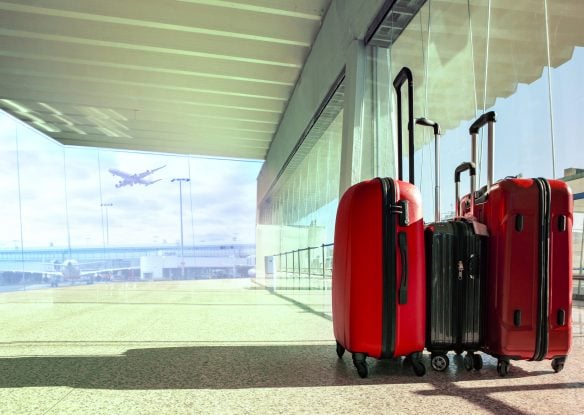As we hit peak travel season in the U.S., passengers with disabilities still bear the brunt of airline travel turmoil, responsible for an over 200% rise in consumer complaints against airlines since before the pandemic.
Airline cancellations and delays have a much more significant effect on people with disabilities, spurring the Department of Transportation to publish the first ever Airline Passengers with Disabilities Bill of Rights. We broke down this 16-page document into a more digestible guide for quick reference. Click the following link to jump straight into the overview.
Jump to the Airline Passenger with Disabilities Bill of Rights Guide
International travelers who live with a disability, like Francesca Elisabetta Owens, are experiencing some of the worst treatment since before the passage of the Air Carrier Access Act (ACAA). A Certified Travel Coach and Ambassador to Italy for the Travel Coach Network, Owens was initially excited to see the new bill of rights, only to be disappointed.
“Some of these points are so obvious and really add little value,” Owens explained. “Other points are so vague that the person behind the airport counter or the plane staff will not understand a ‘practical use’ of interpretation… The language is too general just to come out and say that we are allowed to jump lines to the front and be serviced before the non-disabled people.”
Owens has lived with a disability since she was 44 after an athletic lifestyle, a pregnancy at age 40 and two heart surgeries “collided,” which means she cannot stand or sit in one place too long. As a world traveler, Owens reports that Americans are often at the root of her worst airport and airline experiences, including ADA ignorance, bullying, and people questioning her rights.
While the new bill of rights may be underwhelming to some, David Reischer, Attorney and CEO of LegalAdvice.com, described it as more of a stepping stone that is important to the actual implementation of the ACCA law.
“The passage of the Air Carrier Access Act (ACAA) in 1986, which made it illegal for airlines to discriminate against passengers because of their disability, has only recently been properly funded to enforce compliance to protect air travelers with disabilities,” Reischer explained.
The new bill of rights assists in clarifying some fundamental rights of air travelers with disabilities, according to Reischer, especially in areas of assistance and accommodation with boarding, deplaning, making connections, tailored seating and airline’s safe handling of passengers’ assistive devices.
Airline Passengers with Disabilities Bill of Rights Guide
Click on any of the links below to jump to the question you are looking to answer. The bill of rights consists of ten sections we reconfigured for comprehension and digestibility. Sections 1-5 answer basic questions surrounding the bill’s creation, and sections 6-12 summarize the bill’s contents. If you prefer to read the bill in its original form, click here to redirect to the DOT.
- What is the Airline Passengers with Disabilities Bill of Rights?
- When Did the Passengers with Disabilities Bill of Rights Take Effect?
- Why Was the Bill of Rights Created?
- Who is the Bill of Rights for?
- Where Does the Bill of Rights Apply?
- What Airlines Can’t Do to Passengers with Disabilities
- What Airlines Must Do for Passengers with Disabilities
- Airline Passengers with Disabilities Rights to Service
- Airline Passengers with Disabilities Rights to Accessibility
- Airline Passengers with Disabilities Rights to Accommodations
- Airline Passengers with Disabilities Rights to Bring Assistance and Service
- Airline Passengers with Disabilities Rights to Conflict Resolution

1. What is the Airline Passengers with Disabilities Bill of Rights?
It is not a new law but a summary of existing laws that bring awareness to the rights of airline passengers with disabilities. The bill of rights is a living document that the Department of Transportation will update if regulations change.

2. When Did the Bill of Rights Take Effect?
The bill was published in July 2022 but did not introduce or remove any new laws. It only serves to consolidate and summarize existing laws.

3. Why Was the Bill of Rights Created?
The DOT press release cites the over 300% rise in consumer complaints against airlines since before the pandemic, in addition to the need to protect all passengers and ensure an air travel system that works for everyone.

4. Who is the Bill of Rights for?
The bill follows the Nondiscrimination on The Basis of Disability in Air Travel clause of Title 14 in the Code of Federal Regulations. It applies to anyone with a disability as defined there. The definition is extensive but generally applies to any individual with a permanent or temporary physical or mental impairment that substantially limits major life activities, such as walking, hearing or breathing. Airlines and airports share equal responsibility to meet the requirements of this law.

5. Where Does the Bill of Rights Apply?
The bill protects flight passengers within the entire U.S. and passengers on flights to or from the U.S., even on foreign carriers, including on airline sub-contractors.

6. What Airlines Can’t Do to Passengers with Disabilities
-
Airlines cannot refuse service because of one’s self-identified disability or anything resulting from that disability.
-
Cannot make travelers with disabilities accept any unique service or subject them to special restrictions other than early check-in, requiring advanced notice or early boarding. For example, do not make a person with disabilities use a wheelchair when they only requested a sight guide.
-
Airlines cannot leave passengers who are not independently mobile and use wheelchairs unattended for more than 30 minutes.
-
Airlines must never hand-carry passengers anywhere except in the event of an emergency.

7. What Airlines Must Do for Passengers with Disabilities
-
Airlines must train personnel in direct contact with travelers to accommodate passengers with disabilities safely, respectfully, and with dignity. Personnel must complete refresher training every three years.
-
Airlines must train personnel to provide prompt, timely boarding and deplaning assistance for passengers with disabilities.

8. Airline Passengers with Disabilities Rights to Service
-
Upon request, airlines must provide information to travelers with disabilities about the facilities and services available that are specific to their aircraft. This requirement is waived if there is a last-minute aircraft substitution. Information includes any limitations to accommodating passengers with disabilities. Airlines must give this information with or without request to persons using wheelchairs for boarding.
-
Prompt service must be available for passengers who need visual or hearing assistance at the ticket area, service desk and aircraft. Airlines and airports must train personnel to recognize such requests immediately and to communicate with passengers in a commonly preferred manner, including writing notes, passing out Braille cards, reading information sheets passengers provide and speaking through an interpreter.
-
Upon request, airlines must provide immediate enplaning and deplaning assistance for passengers with disabilities, including the use of ground, boarding and onboard wheelchairs, ramps, lifts and motorized carts.
-
Prompt personnel must assist passengers from the drop-off curb to the departing flight with assistance between gates and making connections. Aid must be available to take passengers from the landed plane to the curb for pickup, accessing ticket counters, baggage claim, restrooms and escorting passengers with service animals to animal relief areas. In addition, assistance must be available to move passengers to and from seats, the lavatory and stowing/retrieving carry-on items.
-
Airlines must provide additional time, assistance and accessibility equipment for passengers who self-identify as needing help with a disability at the gate.
-
Airlines must staff a Complaint Resolution Official at every airport to be immediately available to answer urgent questions about the rights of passengers with disabilities at all times the airline is operating.

9. Airline Passengers with Disabilities Rights to Accessibility
-
Airlines using aircraft with more than 60 seats must maintain accessible websites for those needing visual or hearing assistance. A quarter of all automated kiosks in airports with 10,000+ enplanements yearly must be accessible automated kiosks.
-
Airlines must self-police to ensure every terminal owned, leased or otherwise controlled by the airline is immediately accessible and usable by passengers with disabilities at all U.S. airports and foreign airports with U.S.-bound flights.
-
Airlines must ensure accessible routes between all gates and aircraft boarding.
-
A ramp or mechanical lift must be available for passengers with disabilities when level-entry boarding is unavailable. An example of level-entry boarding is a jet bridge with no more than 5.5 inches verticle distance between platform and airplane and no more than 10 inches horizontal distance.

10. Airline Passengers with Disabilities Rights to Accommodations
-
Airlines must coordinate with airport operators to ensure accessible relief areas for service animals at all U.S. and foreign airports with U.S.-bound flights.
-
Half of a plane’s aisle armrests must be movable on any aircraft starting operation after 1992 with 30+ seats. Any seat renovations on planes older than 1992 must bring the craft to this standard.
-
Any plane with more than one aisle must provide at least one accessible lavatory.
-
Any aircraft with 100+ seats must contain at least one cabin storage space for a normal-sized collapsible manual wheelchair or battery-powered wheelchair if it fits. Any manual wheelchairs too large for cabin storage must be safely and securely stowed in the cargo compartment to immediately retrieve upon landing for passenger’s use at the gate.
-
Airlines must accommodate seating requests from passengers who tell airlines they need such seats as long as the preferred seat is within the same class the passenger booked. Seating accommodations include moveable aisle armrests, bulkhead seats, greater leg room, and adjoining seats for assistive companions. Airlines have several methods to ensure these accommodations are available, including block, priority and preboarding.

11. Airline Passengers with Disabilities Rights to Bring Assistance and Service
-
Airlines must allow passengers with disabilities to carry on assistive devices free of charge, including but not limited to medical devices and medications. These items do not count as the passenger’s allotted carry-on, and they may still bring an additional carry-on item.
-
Airlines must allow service dogs to accompany passengers with disabilities. Passengers must present DOT forms for their service animals to airline staff. Airlines may reserve the right to refuse service animals only if this form is not shown, the dog is directly threatening, is causing significant turmoil or would violate U.S. or foreign laws. Airlines must take all steps to minimize risk and likelihood of further harm before taking such drastic actions, including all available mitigation tools — airlines cannot deny service if means exist to mitigate the problem.

12. Airline Passengers with Disabilities Rights to Conflict Resolution
-
Airlines must fully compensate for the loss, damage or destruction of wheelchairs or other assistive devices up to the original purchase price.
-
Complaint Resolution Officials must be available promptly (including by phone) to resolve disability-related issues on the spot.
-
Any passenger with a disability not satisfied with air travel services can file complaints with the airline, the DOT, FAA or DOJ.
-
Passengers must file complaints within 45 days of the incident. Airlines have 30 days to address the issue.
-
Complaints first filed with the DOT will be referred to the airline after investigation within six months. You still must file within 45 days of the incident, even though the DOT can take up to six months to investigate.



















































